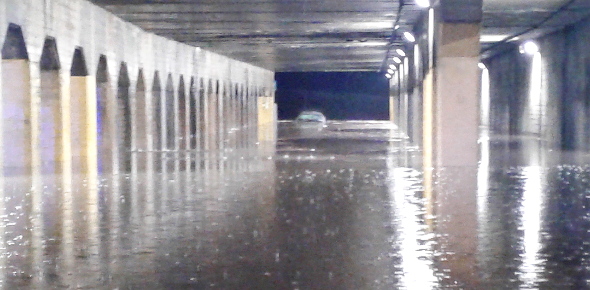During a rain and hail storm on Feb. 28, one driver found out the hard way what most local motorists know: The Dixie Highway viaduct in Homewood is prone to flooding.
The driver was rescued from the vehicle that stalled in several feet of water. The lesson? When hard rain comes down, it’s best to go around.

(Chronicle file photo)
During the same storm, the 183rd Street and Flossmoor Road viaducts also flooded. But those structures have drainage systems that help clear roadways quickly, so they rarely are impassable for long, according to Homewood Public Works Director John Schaefer.
Dixie Highway viaduct, on the other hand, was closed for hours during and after that storm.
The flooding problem is not new. In fact, it could be as old as the viaduct, built in 1922.
A study commissioned by the Illinois Department of Transportation in 2004 notes that “the existing drainage system operating at maximum capacity would not provide a 10 year design flow protection against flooding under the viaduct.”
A “10 year design” means the system could handle water from a storm that has a 10 percent chance of occurring in any given year. According to Village Engineer Max Massi, such a storm likely would produce 2.1 inches of rain in an hour. More rain than that in an hour would likely produce flooding, as would the same rate of rain for more than an hour.
Bringing the system up to a 10-year design flow is one option described in the 2004 report.
Another option would be to bring the system up to a 50-year design flow capacity. In that case, the system would be able to handle a storm with a 2 percent chance of occurring in any given year, or 3.04 inches of rain in an hour.
The problem now is not only an inadequate system design but degradation of its capacity because of deterioration over the years.
The 2004 report states that the system is “generally moderately to severely deteriorated.” There are places where pipes have collapsed, preventing water flow and causing sediment build-up and tree-root invasion.
Sediment was cleaned out in 2003, but Schaefer said no additional rehabilitation work has been done since then.
Residents expressed concern about the situation Tuesday at a public hearing for a proposed downtown tax increment financing (TIF) district.
Sue Pulaski and Danielle Nolen-Ragland asked whether viaduct drainage could be included in projects receiving TIF funds.
“If we’re really trying to develop downtown Homewood, when there’s a bad rainstorm no one can get there,” Pulaski said. She noted that flooding there seems to be happening more frequently.
“I’d be interested in finding out what the plans are for how we’re going to move forward,” Nolen-Ragland said.
In response, Mayor Richard Hofeld said IDOT has jurisdiction over the drainage system and village officials have asked the agency to address the problem.
“We meet with them all the time and try to get it on their radar,” he said.
A meeting between IDOT and village officials in December might have helped.
IDOT officials said they are initiating the first phase of a study to explore possible solutions that could be implemented sometime in the next five years ― if funding becomes available.
The first phase of the study is expected to be completed by the end of 2018, according to IDOT spokeswoman Gianna Urgo.
She noted that IDOT is beginning discussions with the village and with the two railway companies, Metra and CN, that own the deck and tracks over the viaduct.
The current cost estimate for a 50-year design standard is about $850,000, she said. That’s up from about $766,000 estimated in the 2004 study.
The project is currently targeted for sometime late in IDOT’s FY 2017-2022 multiyear program, Urgo said.
“Dates depend on plan readiness, land acquisition and funding through annual legislative appropriations,” she said.

